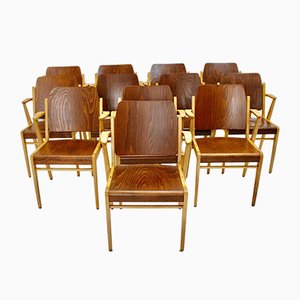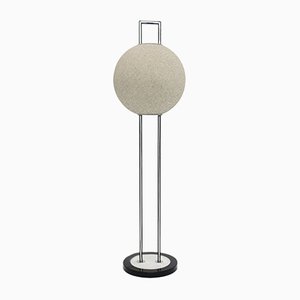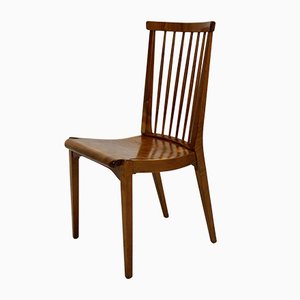Born into Swedish nobility as Lena Rabenius in the provincial Småland town of Tranås (1919), Lena Larsson is revered across Scandinavian design circles for her multi-form and passionately child-centric contributions to the Nordic legacy of rational functionalism in furniture and interior design.
She began her trailblazing arc at Carl Malmsten’s Verkstad (viz., furniture design) school in Stockholm, where she studied to become a cabinetmaker. A subsequent 1939 internship at Swedish furniture company Futurum notwithstanding, Larsson received her first professional break in the early 1940s, working for Elias Svedberg’s namesake firm in Stockholm. Brought on to sketch designs for a few small-scale projects, Larsson exhibited a talent and design sensibility that quickly garnered her a larger company role, which culminated in her involvement with Svedberg’s Tra i trä chair (ca. 1943). Prepared for—and ultimately winning—Svenska Mobelfabrikerna Bodafors’ 1943 competition Den Moderna Familjebostadens Behov (lit. The Needs of the Modern Family Home), this piece, Svedberg’s original iteration of ready-made furniture, was a precursor to the intuitive designs later popularized by fellow Swedes through IKEA.
Following these initial years with Svedberg, Larsson detoured into pedagogy and the public sphere. In 1946, she began a professorship at Konstfack (onward intermittently, until 1983), concurrent with a role she commenced a few years earlier (1944) providing housing surveys for the National Association of Swedish Architects (SAR) and the Swedish Werkbund (Svenska Slödföreningen). These surveys, whose data was to inform postwar templates of national housing schemes, unearthed midcentury Swedish families’ serial misuse of their interior space, in which ostentatious furniture often stood in places better allocated to children and functional needs. It was this discovery that catalyzed the practical and child-conscious essence of Larsson’s later design and teaching efforts.
After administering the surveys, Larsson traveled the country under Werkbund commission to educate the Swedish population on the tenants of rational (i.e., space-optimizing) habitation. Then, in 1947, she rejoined forces with Elias Svedberg—this time to lay the groundwork for Nordiska Kompaniet’s newfound specialty outlet NK-bo. An incubator for experimental design and young Swedish furniture talent—launching careers that spanned from Stig Lindberg to Yngve Ekström—NK-bo and its products were unpretentious, convenient, and affordable, altogether tailored to a clientele younger and less affluent than was the NK norm.
Both simultaneous to and after her tenure at NK-bo (which ended in 1956), Larsson was engaged in a number of creative projects across media. In the summer of 1955, she provided the interior for her husband Mårten Larsson’s Skal & Kärna (Peel & Kernel) design for the major housing and home furnishing exhibition, H55. Then, a year later, she left NK-bo to serve as chief editor of Swedish home decoration magazine Allt i hemmet. Writing, in fact, became the prolific focus of her later career. Beyond columns for the daily newspapers Expressen and Stockholmstidningen—as well as her seminal 1960 “Köp, slit, slâng” (“Buy, wear and tear, throw away”) article in the esteemed Nordic design magazine Form—Larsson produced some twenty books on subjects ranging from interior decoration to children, nature, cooking, and memoir.
She passed away in 2000.
























Contattaci
Fai un'offerta
Abbiamo notato che sei nuovo su Pamono!
Accetta i Termini e condizioni e l'Informativa sulla privacy
Contattaci
Fai un'offerta
Ci siamo quasi!
Per seguire la conversazione sulla piattaforma, si prega di completare la registrazione. Per procedere con la tua offerta sulla piattaforma, ti preghiamo di completare la registrazione.Successo
Grazie per la vostra richiesta, qualcuno del nostro team vi contatterà a breve.
Se sei un professionista del design, fai domanda qui per i vantaggi del Programma Commerciale di Pamono